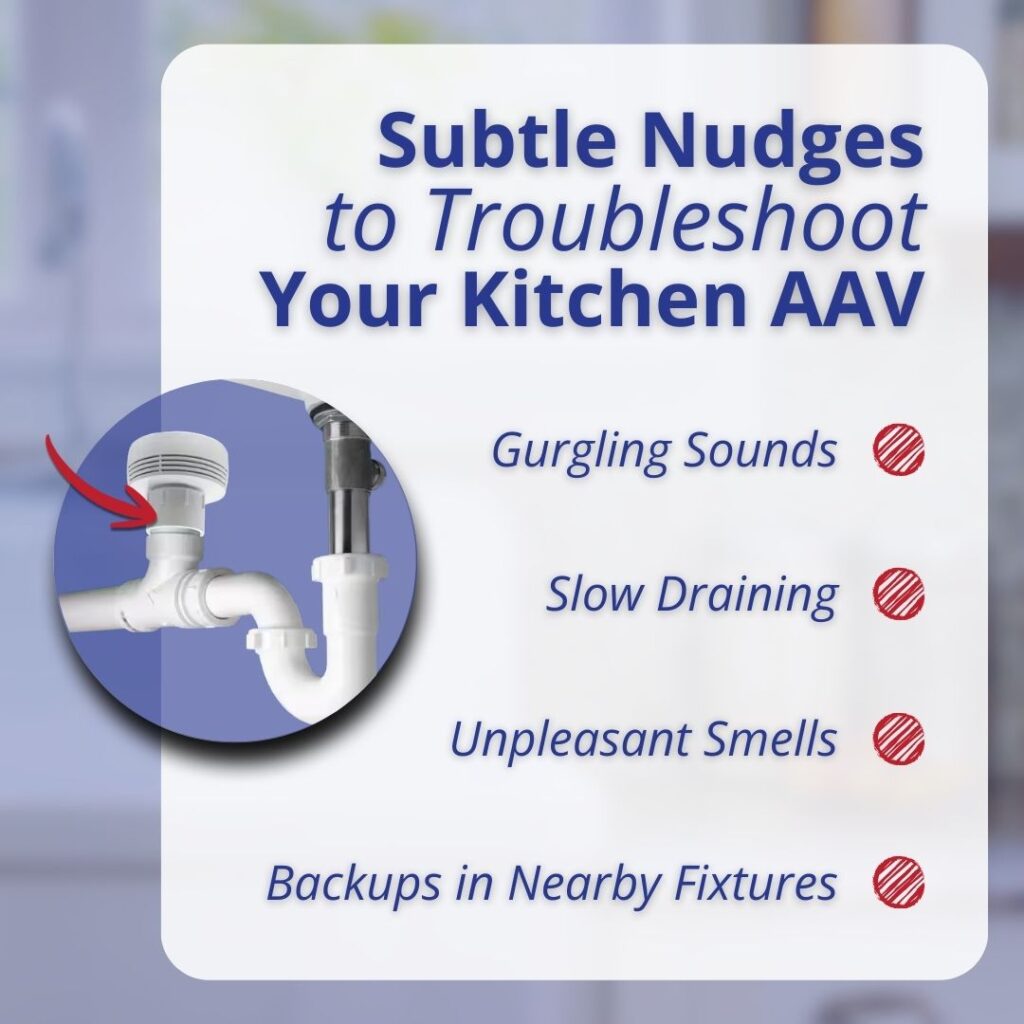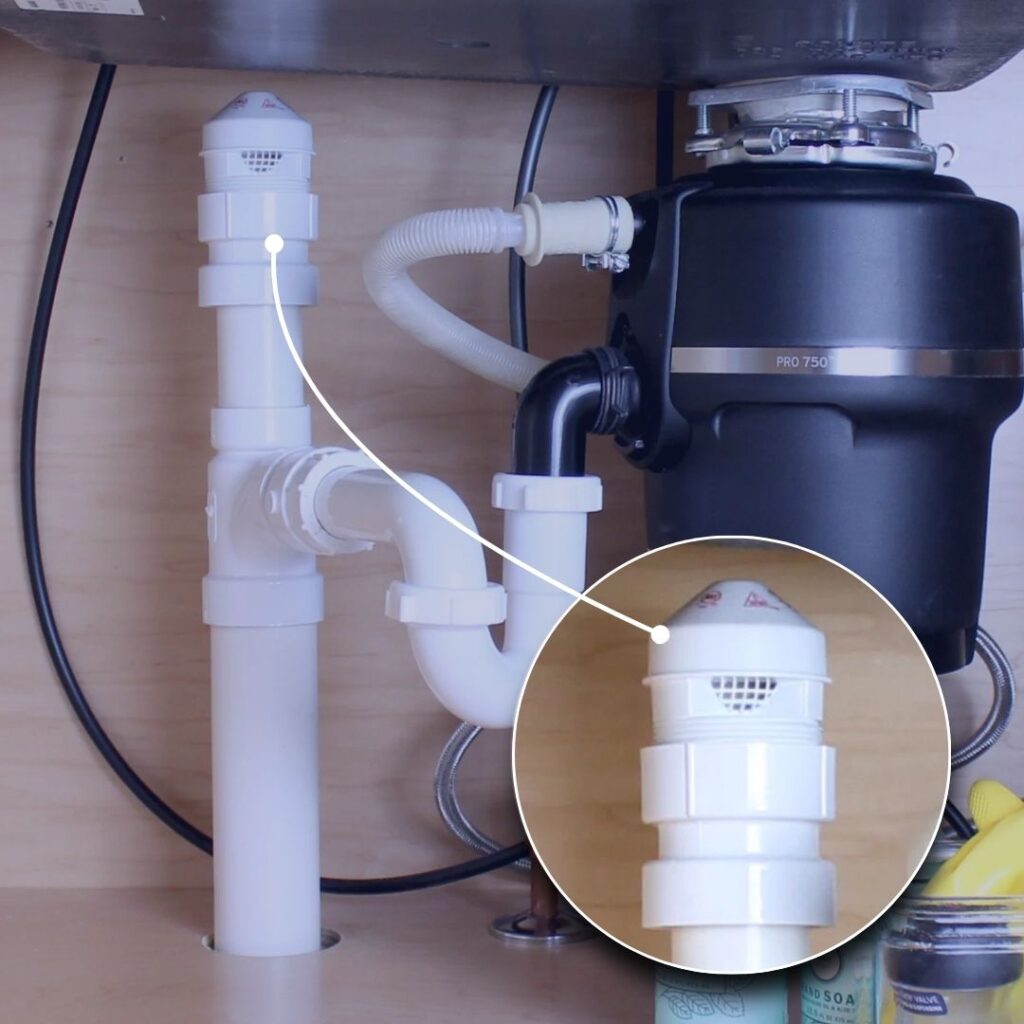A kitchen sink that gurgles, drains slowly, or smells bad is more than just annoying. These issues are often linked to a small device under the sink called a mechanical vent, also known as an air admittance valve (AAV). Troubleshooting your mechanical kitchen sink vent starts with knowing what it does and how it fails.
Here’s how a vent like this works, what can go wrong, and what you can do about it.
What a Mechanical Vent Does
Every drain in your home needs a way to balance air pressure. Without it, the water in the pipes can create suction, which slows drainage and pulls water out of the trap. The trap is the U-shaped pipe under your sink that blocks sewer gases from coming back into your home.
Traditionally, homes use roof vents to handle this job. In places where adding a roof vent is not practical, such as island sinks or remodels, plumbers install a mechanical vent.
Here is how it works:
- When you run water, the vent opens to let air into the pipes.
- When the water stops, the vent closes to keep sewer gases out.
It is a simple design, but if the valve sticks open or closed, the system fails.
According to the International Association of Certified Home Inspectors (InterNACHI), air admittance valves are widely approved in the U.S. and are commonly used in modern homes because they save time and reduce the need for multiple roof vents.

How to Tell If Your Mechanical Vent Is Failing
- Gurgling Sounds: If your sink makes a bubbling or gurgling noise when draining, the vent may not be pulling in enough air. The vacuum effect forces air through the water in the trap, which creates the noise.
- Slow Draining Water: A vent that is not working can restrict flow, leaving water standing in the sink. This often gets worse if other drains are used at the same time.
- Unpleasant Odors: If the valve does not close properly, sewer gases can leak into the kitchen. This is not only unpleasant but also unhealthy.
- Backups in Connected Fixtures: Dishwashers that drain into the same line may push water back into the sink if the vent is not working. If multiple fixtures are acting up at once, the vent could be to blame.
Troubleshooting Steps You Can Try
Step 1: Find the Vent
Look under your kitchen sink, near the drain trap (the curved U-shaped pipe). The mechanical vent is usually a small plastic piece mounted on a vertical pipe beneath the kitchen sink. It may look like a short stack with slits or slots.
Step 2: Do a Visual Check
Inspect the vent for obvious signs of damage, such as cracks, corrosion, loose fittings, or anything blocking the top. Wipe it down with a clean rag if it looks dirty or greasy. If the vent is not vertical or is located below the height of the drain trap, it may have been installed incorrectly and could be malfunctioning.
Step 3: Listen and Observe While Running Water
Turn on the faucet and let water flow down the drain for 30 to 60 seconds. Watch how fast it drains and listen for sounds:
- A healthy vent may make a quiet clicking sound as it opens and closes.
- Gurgling, bubbling, or delayed draining may point to a failed vent.
- If the water pauses, then drains in a rush, that may be a sign of trapped air in the line.
Step 4: Try the Drain Stopper Test
Plug the sink with the stopper, fill it halfway, then release the stopper quickly. This rapid drain should create a strong suction that triggers the vent. If the water drains very slowly or makes loud gurgling, the vent may not be admitting air as it should.
Step 5: Try Smelling for Odors Around the Vent
Turn off the water, wait a few minutes, and take a cautious sniff around the vent housing. A properly sealed vent will not release any odor. If you notice a sewage-like smell, the seal may be cracked or the vent stuck open.
Step 6: Check for Repeat Symptoms
Use nearby fixtures like the dishwasher or a second sink, and observe whether the main kitchen sink reacts (such as backing up or bubbling). A faulty AAV can affect nearby drain behavior, especially if they share a waste line.
Step 7: Replace the Vent If Needed
If the vent is more than 7 years old, showing signs of failure, or not responding to any basic fixes, replacement is usually the best option. Most AAVs are inexpensive and screw off by hand. You can take the old one to a hardware store to match the size and brand.
Before replacing, always shut off the water to the sink and place a bucket or towel under the pipe. If you are unsure how to disconnect or test the part, it is safer to call a plumber.
Why Mechanical Vents Stop Working
A mechanical vent will wear out over time, especially in a busy kitchen sink. The most common causes include…
- Age: Rubber seals harden and lose their ability to close tightly.
- Grease and food particles: Build-up inside the vent can prevent it from sealing.
- Improper installation: If the vent is installed too low or too close to the trap, it may not function correctly.
- Temperature changes: Dishwashers can push hot steam into the pipes, while cold drafts in older homes can stress the valve.
Plumbing experts note that improper installation is one of the leading reasons vents fail early, which is why professional installation is always recommended.

Other Questions Homeowners Ask
Are mechanical vents legal in Charlotte?
Yes. They are allowed under the North Carolina Plumbing Code, as long as they meet International Code standards and are installed correctly.
Can I replace one myself?
Yes, many homeowners do. Most vents simply screw into place. But if you are unsure about plumbing codes or how your system is set up, a plumber can make sure it is installed correctly.
How long do they last?
Most mechanical vents last 5 to 15 years. If your vent is older than 10 years or showing signs of failure, it is smart to inspect or replace it before it causes bigger issues.
What happens if I ignore the problem?
If left unresolved, a faulty vent can cause constant clogs, allow sewer gas into your home, and strain other parts of your plumbing system.
When to Call a Professional
Some vent issues are simple to troubleshoot, but there are times when it is best to get help:
- You notice constant sewer odors in your kitchen
- Water backs up into the sink when the dishwasher runs
- More than one fixture is affected at the same time
- You replace the vent, but still have the same problem
In the Charlotte area, homes with island sinks and open kitchen layouts often rely on mechanical vents more than older designs. A professional inspection will confirm whether the vent is the issue or if a larger plumbing problem is at play.
Conclusion
A faulty mechanical vent can make your kitchen sink noisy, smelly, and frustrating to use. The good news is that these vents are simple devices and often easy to replace. By learning the signs of failure and taking quick action, you can avoid bigger plumbing issues down the road.
If you are not sure whether your vent is the problem or want a professional opinion, call the America’s Choice team today. Our professionals homes across Charlotte and the surrounding areas, catching small issues before they turn into more stress for you.


